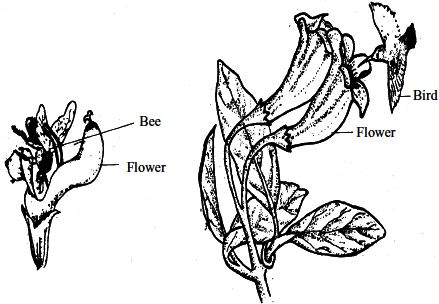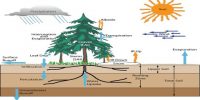Pollination is the procedure of reproduction in plants. This procedure requires at least one agent of pollination to move the pollen between male and female flowers. Pollination, especially cross-pollination takes place by four different agents like insects, wind, animals, and water. It is the transfer of pollen from a male part of a plant to a female part of a plant. This transfer of pollen enables fertilization and the production of seeds.
A short description of this stated below:
(1) Pollination through insects: In most cases at the time of collection of Vnectar pollen grains from one flower is transferred to another flower by insects. Flowers in which pollination occurs through insects are known as entomophilous flowers. Mustard, Basils, Orchids, Roses, Cucurbita, etc. are entomophilous flowers.
(2) Pollination through the wind: Wind is another good agent of pollination. In many plants, Pollination occurs through the wind. Flowers in which pollination occurs, through the wind, are known as Anemophilous flowers. Paddy, Wheat, Maize. Sugarcane, Palm, etc, are Anemophilous or wind-pollinated flowers. Examples of wind-pollinated flowers are corn, rice, and grasses.
Characteristic of Anemophilous flowers:
- Flowers are usually unattractive and have inconspicuous color.
- Flowers usually are without sweet scent and nectar.
- Pollen grains are very light and are produced in large numbers.
- They produce great numbers of very tiny pollen grains that are scattered far and wide by the wind.
- Stigmas are large, feathery and sticky, so that pollen grains carried by wind may attach very easily.
- The stigma is feathery or sticky. Pollen grains stick to it easily.

(3) Pollination through Animals: In many flowers, pollination occurs through Birds, Bat or Snails, etc. Flowers that are pollinated by animals are called zoophilous flowers. Birds have good vision but a poor sense of smell. Hence, the flowers they pollinate are often large and brightly colored, usually red and yellow and odorless. Madar, Shimul, Kadam, etc. are zoophilous flowers. The long-nosed bat feeds on pollen of night-blooming flowers. They feed at night. They are probably attracted to flowers by the smell. Examples of flowers pollinated by bats are those of areca palm, candle tree, and durian.
Characteristics of zoophilous flowers
(a) Flowers are usually large.
(b) Flowers have bright color,
(4) Pollination through Water: Many aquatic plants are pollinated by water. When pollination is accomplished by water the flowers are said to be hydrophilous flowers. Vallisneria, Urticularla, etc. are Hydrophilous flowers.
Characteristics of hydrophilous flowers:
- Flowers are usually unscented.
- They grow underwater.
- Female flowers are solitary and with a long stalk.
- Male flowers are light, transferred by water through floating.
Types of Pollination
All flowering plants rely on pollination for reproduction. There are two types of pollination, called self-pollination and cross-pollination.
Self-pollination is the more basic type of pollination because it only involves one flower. This type of pollination occurs when pollen grains from the anther fall directly onto the stigma of the same flower.
Cross-pollination is a more complex type of pollination that involves the transfer of pollen from the anther of one flower to the stigma of a different flower.














